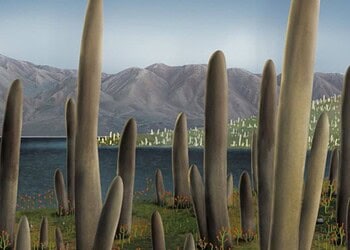
Researchers in a laboratory in Montana have been growing a new kind of building material. It’s not forged in a furnace or cast in molds, but carefully cultivated like a living organism.
The breakthrough, published April 16 in Cell Reports Physical Science, uses scaffolds made from fungal mycelium — thread-like structures that fungi use to spread. These scaffolds are mineralized with the help of bacteria to produce self-healing, living materials that last for at least a month. And with further refinement, they might survive much longer.
Why fungi?
Traditional building materials like cement are a massive environmental problem. Cement alone contributes up to 8% of global carbon dioxide emissions. Researchers have long searched for alternatives that are not just strong and durable, but also environmentally responsible.
One of the most promising strategies is to grow materials using living organisms. Known as engineered living materials, or ELMs, these can offer useful features like self-repair, environmental responsiveness, and even photosynthesis. However, they’ve typically come with a trade-off: they die quickly and lack the internal complexity needed for real-world structures.
That’s where the new study comes in.
The team used a common fungus called Neurospora crassa, known for its fast-growing mycelium. These filaments naturally form a dense, sponge-like matrix — a perfect scaffold to support other living cells.
“Mycelium scaffolds are quite useful for controlling the internal architecture of the material,” said corresponding author Chelsea Heveran, an assistant professor at Montana State University.
That architecture turned out to be key. It allowed the researchers to craft materials with internal geometries mimicking the osteons of human bone — circular structures that both strengthen and nourish our skeletons.
But the problem is still making it sturdy enough.
Bacteria comes in

To make these scaffolds strong, the team turned to a microbial trick called biomineralization. This process uses microbes to produce calcium carbonate — the same mineral found in seashells and limestone.
The fungus itself can trigger this process, but the researchers also introduced a bacterium called Sporosarcina pasteurii, known for its ability to convert urea into carbonate and precipitate calcium carbonate efficiently.
Both fungal and bacterial methods worked. In fact, the bacterially mineralized scaffolds reached full mineralization in just 24 hours and were significantly stiffer. Under the microscope, the calcium carbonate bridged the fungal threads like a crystalline net, enhancing strength.
The living components of the material stayed alive for at least four weeks after mineralization, even after drying at elevated temperatures.
Can this replace cement?
Not yet. First of all, it’s not durable enough. Secondly, it’s not strong enough.
“Biomineralized materials do not have high enough strength to replace concrete in all applications, but we and others are working to improve their properties so they can see greater usage,” said Heveran.
Still, the promise is undeniable.
In tests, the new materials exhibited structural features unseen in earlier biomineralized ELMs. Where hydrogels — a common scaffold in previous studies — tend to collapse or dry out quickly, mycelium offered a tougher, more adaptable framework. Unlike cement, it can be shaped easily and patterned to include complex channels and cavities, potentially allowing for vascular-like systems within walls or beams.
The work is still in its early stages. Manufacturing at scale remains a major challenge. The team hopes to extend the materials’ viability further — perhaps to months or years — and explore new functions.
Journal Reference: Cell Reports Physical Science, Viles et al., “Mycelium as a scaffold for biomineralized engineered living materials.” https://www.cell.com/cell-reports-physical-science/fulltext/S2666-3864(25)00116-X






